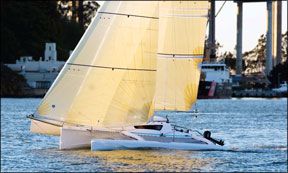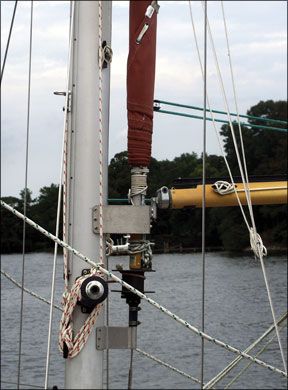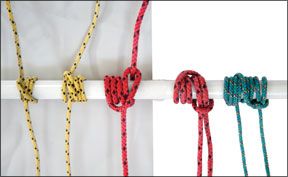Multihull Rebuke You say that the September issues “Need for Speed” article is all about performance? Kidding right? Light-air performance? What you really meant is monohull performance. Any type of non-slug multihull (Corsair tris, Stiletto cats) of the same size will run circles around any one of the boats you reviewed, most particularly in light air. Not mentioning multihulls, the absolute kings of sailing performance, shows a lack of knowledge. Have you seen the recent updates (20 years) in sailing speed records? Are there really any left that are held by monos? Photo courtesy of Corsair Marine 288 Brian Wilson, Practical Sailor received several letters from amused multihullers regarding our review of fast sailing monohulls. The editor, who is currently in an undisclosed location, offers sincere apologies to the owners of Corsairs and Stillettos and other fast multis for not stating up front that the review of performance boats was limited to monohulls. A similar report on multihulls is currently in the works. Interestingly, the aficionados of ice yacht and land yacht racing have been quiet on this subject of speed under sail. As always, we appreciate your keeping us on our toes! Stay tuned for a report on the “real” light-air performers. Towing a Lightning The way I was taught towing Lightnings to LIS regattas, you used a towing hitch around the mast for the line ahead and a similar hitch around the mast for the line to the boat astern. A towing hitch (two wraps around the mast, a wrap around the standing part, back the other way around the mast and two half-hitches around the standing part) could be cast off under tension or even eased under way to place the boat astern on the second wave. Bowlines, we were told, presented a danger of catching a finger in the knot if the towline came under tension while you were catching on or casting off the tow. Recently, a sailing director setting up a tow of Ideal 18s, directed us to tie a bowline with a generous bight around the mast and then to take up the towline from the boat astern and tie a bowline through the bight around the mast. He asserted that this would produce no pressure on the mast at all, as the forward pressure of the tow would be offset by the aft pressure of the boats behind. Can you advise on the best method for securing sailboats in a tow? And what is the optimal distance between boats in a tow? Jonathan DuBois, Weve seen several different ways to tow dinghies, so we asked U.S. Sailing Master Instructor Trainer Guy Fleming of Waikiki Yacht Club for his take on the best method. In his opinion, the optimal way is tying a bowline around the mast and then tie the second boat to that bowline. “If you tie a slip bowline, you will be able to release it under pressure.” As far as the optimal distance between boats, Fleming said one wave length is ideal. “If the lead boat is on a wave, the aft boat should also be on a wave. You don’t want one boat to be climbing while the other boat is descending as it will be a very jerky ride.” Biocides vs. Bugs I read with great interest your article “Biocides vs. Bugs” in the July 2009 edition. As the owner of a company that specializes in cleaning marine diesel fuel tanks (http://www.powersurefuel.com/), I would like to add a few comments. The most costly mistake commonly made by the DIYer is using an alcohol- (or similar) based fuel additive in a diesel tank. Products that claim to “eliminate” or “disperse” water usually do it by using alcohol to emulsify the water in the fuel. The problem with this is that if there is a sufficient amount of water, the emulsified diesel/water solution will ruin the fuel injection pump as well as cause a host of other problems. Even products labeled “Alcohol Free” can sometimes emulsify water. Before putting any additive in a tank, I suggest taking a sample of the diesel fuel, put in some water, the additive, and swirl it around in a glass jar. If the fuel turns Photo courtesy of Dave Herndon 288 from red to pinkish, the water has been emulsified and the additive should not be used. Obviously, my recommendation would be to have the tank professionally cleaned and not take chances with the dockside chemistry experiment. Mark Kappeler, For more on this topic, check out our last review of ethanol additives in the November 2008 issue. Reefurl In your September 2009 article on roller furlers for headsails, you failed to mention that Reefurl also custom-makes fittings for behind-the-mast roller-furling-reefing. Reefurl made custom-made mast fittings and furling rigs for my ketch-rigged motorsailers masts as well as my forestay five years ago. I can now easily unfurl, reef, or furl all three sails in under two minutes from my cockpit. I sail on the Chesapeake Bay almost every day, primarily single handed, and have had zero problems with my three Reefurl systems. A great contact at Reefurl is CEO Rogin Taylor, reefurl@tpgi.com.au. Dave Herndon, The Reefurl behind-the-mast roller furler system can make setting and dousing easy for short-handed sailors. However, the behind-the-mast system is not our first choice for mainsail handling, especially for offshore cruisers. This furling method separates the foil from the sail, which can result in poor sail shape and can make beating to weather an inefficient, mast-fatiguing prospect. It also puts compression loads on the spar. We prefer a conventional mainsail arrangement for small and mid-sized boats. Poli Glow Fan Regarding your September 2009 review of acrylic coatings: I applied Poli Glow (www.poliglow-int.com) to the topsides of my Tayana 37 in 2006. I have not retouched it and it is still going strong! This year, I did my coach roof, nonskid, and decks with it. I used the remains of the 2006 bottle and found the cleaner was sticky and yellowed. I telephoned Poli Glow and found out that both the cleaner and the acrylic have a one-year shelf life and should not be allowed to freeze. Due to this misstep, I ended up using their new foaming-gel Poli Strip, and I can say it works as advertised. I also got their kit for nonskid, which seems like a similar product but uses a short-nap roller for application. It worked great; not only is my nonskid shiny but its still nonskid. Charlie Freeman, Poli Glow Critic Two years ago, I purchased a 1996 Hunter 40.5. I used Poli Glow and followed all the manufacturers directions, using the cleaner first, then applying five coats of the polish. I was thrilled with the results. For the next six months, I outfitted for an extended cruise and did not get the opportunity to sail the boat as much as I normally would. The hull remained bright and shiny. I was so pleased that I used Poli Glow on my coach roof, cockpit combings, and anywhere there was smooth fiberglass. I departed for the Bahamas in November 2008. Three weeks later, my Poli Glow finish looked like it had gone through World War II. The hull, wherever a fender had hung appeared dull and scratchy. Everywhere on deck that was used to sit, grab, or walk was a dark mess of worn polish. Upon my return in March 2009, my problem became one of removal. After three days of scouring, I finally removed enough to use a good paste wax, which, though it isn’t as bright and shiny as the Poli Glow, nonetheless, does not wear or discolor. David Corbett, Photo by Beth Leonard 288 SeaWings, 1996 Hunter 40.5 We contacted Poli Glow President Howard Marsch to get his take on your experience. He advised that users should wash the boat with mild soap and water, never strong detergents or degreasers, which can cause some of the problems you described. He also suggested recoating annually. According to Marsch, “a rubbing fender will wear off Poli Glow, leaving bare exposed fiberglass that will absorb stains easily. Suntan lotion and perspiration can cause a chemical reaction with Poli Glow. This will cause the area to have a dark discolored appearance. Use an abrasive cleaner, rinse and reapply Poli Glow.” The cleaner we assume you used, Poli Prep, has a one-year shelf life. A new cleaner, Poli Strip, is an aerosol gel that is sprayed on and hosed off, a much easier removal routine. Marsch suggested that anyone having problems with a Poli Glow product or application contact the manufacturer directly at 800/922-5013 or e-mail poliglowproducts@aol.com. Poli Glow has consistently performed well in Practical Sailor
Corsair F-24
Narragansett Bay, R.I.
Indian Harbor Yacht Club
Greenwich, Conn.
PowerSure Fuel Reconditioning
and Tank Cleaning Service
1978 Fisher 25 Motorsailer
White Stone, Va.
Kamaloha, 1988 Tayana 37 #542
Via e-mail
New Bern, N.C.
Not The Knot
You indicated in the September Mailport that readers could find how to tie an icicle hitch at www.bethandevans.com. The icicle on their website is not the same that you show in the Mailport picture or in the August 2009 article on gripping hitches. One is a variant of the other. The International Guild of Knot Tyers forum says there is no single definitive icicle knot, but which is the one you tested? The one pictured in the August issue or the one on www.bethandevans.com?
Eric Rabenold,
Via e-mail
We apologize for any confusion. The knot originally pictured on
www.bethandevans.com was indeed a variation of the icicle hitch that was tested for grip. However, the website has since been updated and now shows how to tie the exact icicle hitch that was tested in the August issue. See: www.bethandevans.com/pdf/Icicle%20Hitch.pdf.In the wake of our review, Self-made Sailor Dave Malar posted videos of how to tie the icicle hitch (around a closed-end or open-ended pole) and how to tie the icicle hitch variation on his website. Check them out at www.selfmadesailor.com, under “View Knot Videos.”
Knot Matters
The article on hitches in the August 2009 issue was very interesting. Only, the beautiful photos of the several knots considered did not indicate which line is the working line, or in which direction the load is applied, or, for that matter, if it matters.
Emanuel Laufer,
CEOL MOR, C&C 34
Halifax, Canada
Check out the photo above for an illustration of the loaded end for each of the gripping hitches we tested in the August issue. Keep in mind that the direction of pull is parallel to the pole.
Kids Life Vest
Salus Marine Wear Co. (www.salusmarine.com), in Kitchener, Ontario, Canada, makes an infant vest for children 9-25 pounds, which is the smallest Ive ever heard of. The Bijoux Baby Vest is an excellent product for tiny seafarers. People I know who have used them are impressed with their fit and performance.
My wife and I, and our two daughters, 5 and 11, all have various models of Salus life vests. They are comfortable, allow full range of movement, and are well enough ventilated to be wearable on very hot humid days.
Mark Thomas,
Peterborough, Ontario
Thanks for the tip. Salus is sending us a vest to test. Well keep you posted on how it performs on
Practical Sailors tot testers.



































